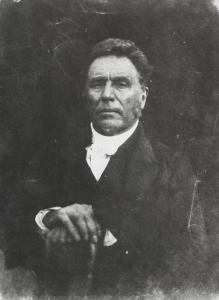Rev.Dr.William Symington
Research and Profile by Gary Nisbet with additional text by Morag Fyfe, Alexander Stoddart and Ruth Johnston
Rev. Dr. William Symington (1795-1862). Epsilon
Symington was a minister of the Reformed Presbyterian Church.
Born in Paisley, on 2 June 1798, he was the son of a weaver, later a woollen and linen merchant, William Symington, and his wife, Marion Brown.
At the age of six he went to elementary school followed by four years at Paisley Grammar School. He became a student at Glasgow University in 1810 at the age of fifteen.
“I was now,” he himself writes in the autobiography, “a thoughtless youth of fifteen in the heart of a great and licentious city, and exposed to the immediate influence of a class of society not the most favourable for cherishing the seeds of pious instruction, not a parent’s eye to watch over my youthful steps, or to awe into the external observance of moral and religious duty.
His time in Glasgow was followed by four years studying for the ministry at the Theological Hall of the Reformed Presbyterian Church in Stirling. He was licenced to preach on 30 June 1818, and ordained at Stranraer the following year, on 18 August 1819.
Soon after settling at Stranraer he married Agnes Speirs in June 1820 and their seven children, three girls and four boys, were all born there. In 1827 the couple lost a son who was born and died on August 22, 1827. Six years later, in 1833, when playing with two of the older children in the manse garden, another of his sons, Robert, died after the stone pillar supporting a sun-dial fell on him. Due to his own experience at school his children were home educated by him and his wife and then by a private tutor until his move to Glasgow in 1839.
During his time in Stranraer he formed an acquaintance of Dr. Chalmers when he visited the area and he wrote “Was surprised this morning by a letter from Dr. Chalmers, announcing that the Senatus Academicus of the University of Edinburgh had, on the 20th, unanimously conferred upon me the degree of Doctor in Divinity. This is a most unexpected honour from man, which will require new grace to keep me humble and to enable me to act consistently.”
His ministry in Glasgow began at the Great Hamilton Street Reformed Presbyterian Church (demolished in 1988). At that timethe congregation was around three hundred, many of whom came from up to eight miles away. The church was situated in the down-at-heel Calton district in the East End of the city, and was one of the finest specimens of Georgian ecclesiastical architecture in Glasgow. Built in 1816, from a design by John Brash, it was originally a Methodist chapel, but by the time Symington arrived as its minister, its denomination had become Presbyterian.
Symington, like many of his clerical contemporaries, was noted for his oratorical skills and his compassion and concern for the poor, particularly regarding the moral and spiritual condition of young men. He was also an esteemed writer on the Scottish Covenant martyrs and spiritual matters in general, his most popular work being Messiah the Prince, which was published in 1839, and regularly reprinted. Symington was photographed by David Octavius Hill and Robert Adamson around 1843, prior to being included in Hill’s gigantic painting of the Disruption of the Church of Scotland: The Signing of the Act of Separation and Deed of Submission (1843-66).
He wrote “May 18th, 1843.— Witnessed the Disruption in the Church of Scotland. A splendid sight, worth living a century to behold! The meeting at Canonmills immense, and proceedings full of deepest interest.” He walked with the great procession from St. Andrew’s Church to Canonmills; attended the Free Assembly the next day; and on the Monday following gave an account of the magnificent event to his congregation. He however did not join the Free Church.
His will was dated 21st March 1845 and in October that year he fell seriously ill for a period of eight weeks and, in the winter of 1848/49, he suffered another long illness.
Following the death of his brother Dr Andrew Symington in 1853 the Synod of the Church which met early in January 1854 unanimously appointed Dr. William Symington to the vacant Chair of Systematic Theology previously held by his brother. The congregation noting the extra work commitments for him invited his eldest son William, then minister at Castle Douglas, to become his colleague and successor and young William finally accepted in March 1859.
The 1851 census shows the three youngest children (Andrew, Agnes Ann and Alexander McLeod) still living at home with their parents but by 1861 they had left the family home in 15 Annfield Place in Dennistoun and were bringing up their own families. Two of his sons and a daughter lived nearby in Glasgow.
Symington died at his home in Annfield Place, on 28 January 1862, after a long bout of influenza. However, after an autopsy was carried out, it was discovered that he had also been suffering from an aneurysm. This had probably been caused by a fall when he slipped on ice some years earlier, and it was this, rather than the flu, that had actually led to his untimely death. Symington’s funeral took place on 12 February and was one of the largest the city had seen for some years. The streets were lined with onlookers, and upwards of sixty ministers of various denominations attended his burial.
Symington’s wife, Agnes Spiers, died ten months later, on 28 October 1862, and was buried beside him. In the years following William and Agnes were joined by their sons Andrew and William, their sons’ wives, a grandson and a granddaughter.
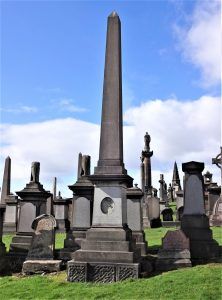
by William Sim, minus its portrait medallion.
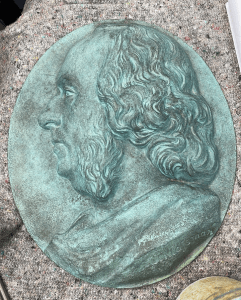
His monument in the Necropolis is in the form of a tall and very slender obelisk, or needle, on a pedestal and steps, signed by its maker, Sim of Glasgow. Carved in grey granite, it was commissioned and paid for by his former congregation. Symington’s bronze portrait medallion occupied the currently empty oval aperture on the front of the pedestal and was produced by John Mossman.
William Sim’s name appears on several monuments in the Necropolis as their maker, including his own, which states that he had been the ‘Contractor to the Police and Statute Labour Committee of the City for Upwards Half a Century’ before his death, aged 81, in 1895. His Necropolis work includes the monuments to Samuel Wilson (c.1860) and Thomas Fingland (c.1863), both of which were made without portraits.
Sim was a native of Paisley and the owner of the Argyll Granite Monumental Works in St. James Street, which he established in 1855, and the lessee of the Furnace-Granite Quarries near Inverary. He also worked quarries at Bonaw and Ross of Mull, which was famous for its red granite. In 1858, he established a granite workshop at 22 Buchan Street in the Gorbals, which he advertised as having ‘a steam engine and machinery for the sawing and polishing of granite, and […] workmen there ready to execute any order – from the rough block, the causeway, or kerbstone, up to the highest class of monumental and ornamental work.’ Amongst those endorsing the quality of his work, he cited the sculptor John Mossman, and John Carrick, the city’s Superintendent of Streets and Buildings. Amongst his ‘high class’ contracts were the colossal granite stairway leading from Clifton Street to Park Terrace in Glasgow (1855), and the Duncan Ban McIntyre Monument on Beacon Hill, Dalmally (1858). His monumental work included the headstone for James Smart, the late Superintendent of Police, in the Southern Necropolis (c.1870) and, of course Symington’s monument in the Necropolis. His firm survived until 1964.
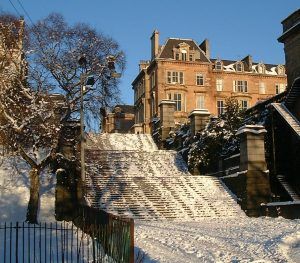
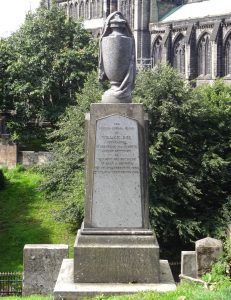
Symington’s monument was well cared for in subsequent years. An entry in J. & G. Mossman’s job book for 1921 records that the monument was washed and cleaned in December that year, and that the portrait was also lacquered and all of the 144 letters in the monument’s inscriptions were repainted. This was done at a behest of Symington & Co., a firm of cork manufacturers and importers based at 7 Royal Bank Place, which was founded by William Symington’s son.
The bronze portrait relief on Symington’s monument disappeared decades ago, but it will be replaced soon owing to its recovery (without identification) by the sculptor Alexander Stoddart some forty years ago. He spotted the item in an antiques auction when a student at Glasgow University. It had obviously been wrenched from a grave monument because of a twist at the top of the field against which the head was modelled. Stoddart felt unable to bid for a stolen lot, a scruple obviously shared by the other auction punters, for the thing appeared again at the following sale. This time he put in a bid and secured the article, firm in his intention to discover where it rightfully resided and to return it there. Believing that he knew every single point of missing bronze sculpture in Glasgow Necropolis, he concluded that it must have belonged in some other ground – but where? He therefor made a paper template of the sculpture and carried it around with him on all his travels around the graveyards of Scotland. Only during a let-up in lock-down in the Covid years did he spot a gaping hole in one of the eastern avenues which he had not seen before. He took a basic measurement and raced home to his studio in Paisley to discover that the fit would be perfect. Internet research made the Symington identification rock solid. Lost … who knows when? Found c. 1981. Replaced 2025.
Sources:
Londonderry Standard: Argyll Granite Monumental Works, 3 June 1858, p. 2;
Glasgow Herald: Deaths, 29 January 1862, p. 5;
Dunfermline Press (Re. funeral), 6 February 1862, p. 2;
Glasgow Evening Post: The Late Dr. Symington, 12 February 1862, p. 3;
J. & G. Mossman Job Book, 1921: 15 December 1921;
Information re. Symington medallion: email from Ruth Johnston, 30 September 2022;
https://en.wikisource.org/wiki/Symington,_William_(1795-1862)_(DNB00);
